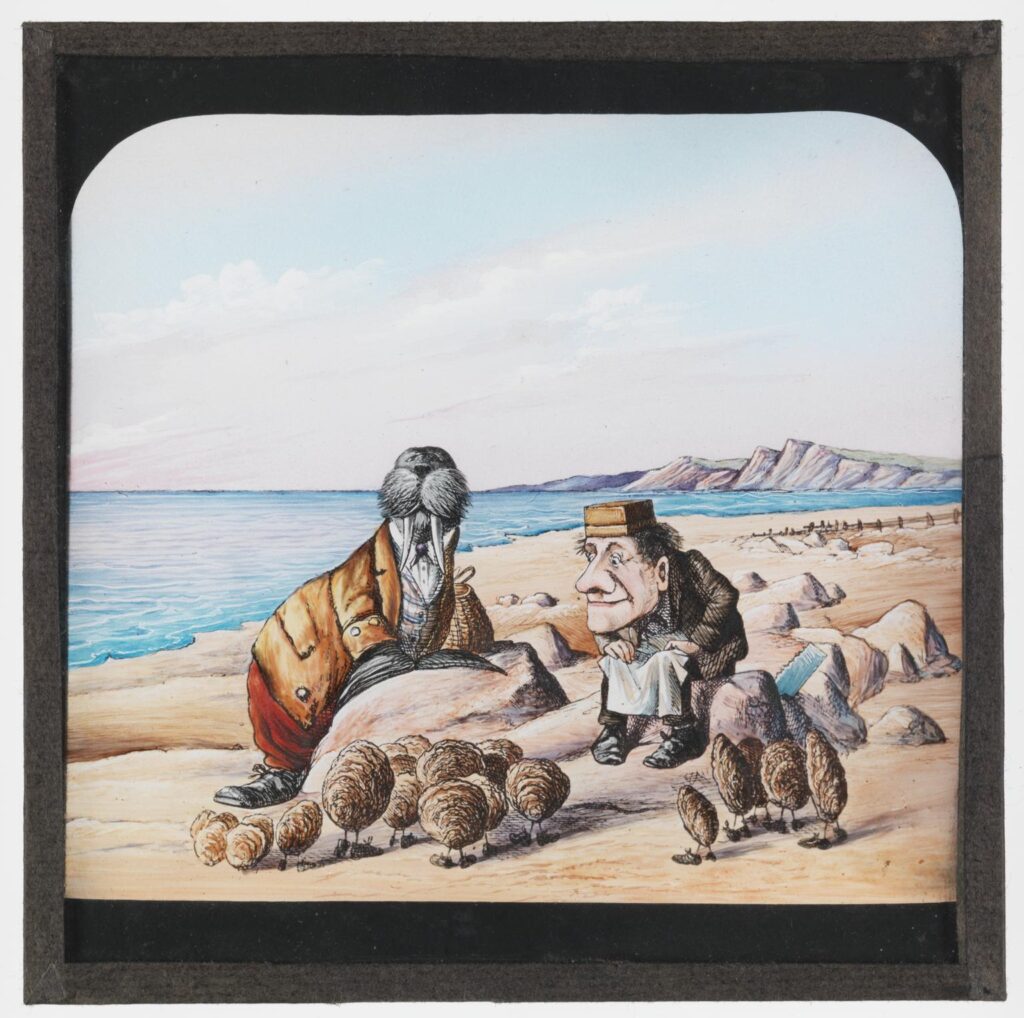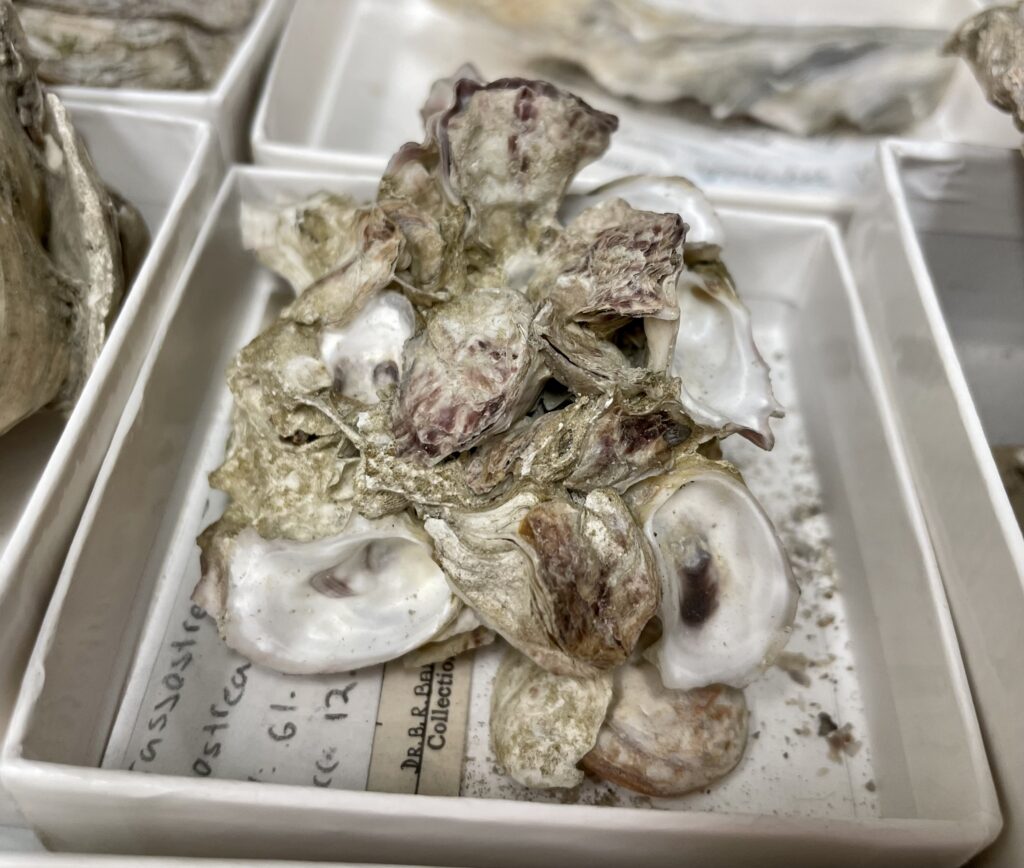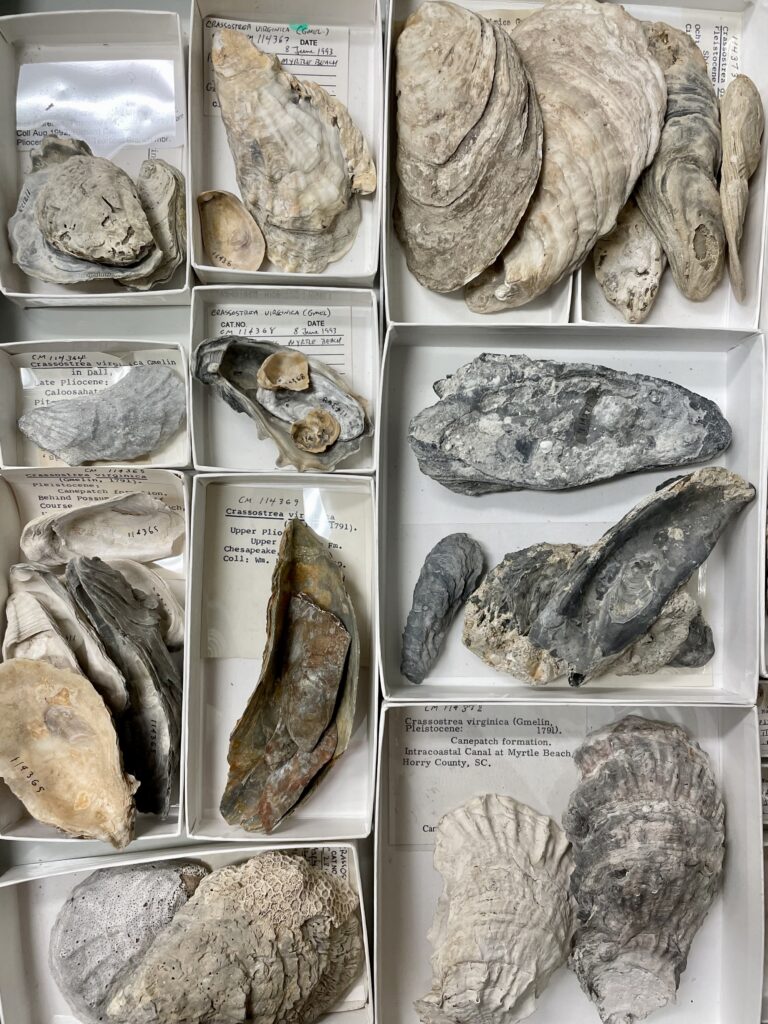by Sabrina Spiher Robinson

“’O Oysters, come and walk with us!’
The Walrus did beseech.
‘A pleasant walk, a pleasant talk,
Along the briny beach:
We cannot do with more than four,
To give a hand to each …
Four other Oysters followed them,
And yet another four;
And thick and fast they came at last,
And more, and more, and more—
All hopping through the frothy waves,
And scrambling to the shore …
‘O Oysters,’ said the Carpenter,
‘You’ve had a pleasant run!
Shall we be trotting home again?’
But answer came there none—
And this was scarcely odd, because
They’d eaten every one.”
In 1872, Lewis Carroll included the poem “The Walrus and the Carpenter” in his classic book Through the Looking Glass. The Walrus calls out to the oysters to join him and the Carpenter on a walk along the seashore; the young oysters don’t know any better and come to join him. Eventually, all the oysters are eaten up. But can one really sing a siren song to make an oyster come to them? An informed answer to this question requires some background knowledge information about an underappreciated form of wildlife.

Oysters live in reefs, submerged ridges or mounds of stable material, and baby oysters prefer to settle on a base — called “cultch” — of old oyster shells. Where conditions are favorable, oysters have plenty of company. When a team of researchers investigated the diversity of oyster reefs in the Gulf of Mexico, they detailed the incredible number of creatures that live on the reefs where oysters form: 115 species of fish and 41 species of crustaceans made the Gulf oyster reefs their homes, at very high densities and in communities containing up to 52 species at a time. Other researchers have documented multiple corals, mollusks, and worms that live primarily on oyster reefs. Unfortunately, erosion from coastal development, wetland destruction, unsustainable harvesting, and pollution have decimated populations of the Atlantic coast’s native oyster, Crassostrea virginica, which is bad news for coastal marine habitats in general.²
The importance of oyster reefs as marine habitats for multiple species is only one reason to preserve and reconstruct them. Oysters, as filter-feeding animals, provide an incredible service to the water quality of the estuaries they inhabit. They are also, of course, an important food source along America’s east coast.
The complications of rebuilding and repopulating oyster reefs are many. Pollution must be reduced, especially the run-off of agricultural fertilizers. Such fertilizers “enrich” underwater environments in a process called eutrophication.
Eutrophication causes massive blooms of algae that set off a chain of events disastrous for bodies of water and their inhabitants: the algae can release toxins on its own, but most commonly it overwhelms host ecosystems by blocking sunlight and killing all of the other plants in the water. Eventually the algae die too, and as all these dead plants decay, eaten away by multiplying bacteria that use up what little oxygen is left, dead zones form that suffocate underwater animals. This decay also lowers the pH of the water, leading to acidification that harms and kills animals (especially mollusks, whose shells dissolve in a very acidic environment). Additionally, if sediment erosion is not reduced, these water-borne materials eventually bury and suffocate oysters.
Oyster bed substrates that have been destroyed by human construction or aggressive commercial dredging can be replaced with cultch that is attractive to baby oysters. However, baby oysters must be recruited to the rebuilt reefs, either from the natural population of oyster larvae, or from hatchery-grown larvae reintroduced to the environment.
So, how to attract a baby oyster to your newly constructed oyster reef? First, let’s consider the life cycle of C. virginica, and the critical importance of age range in young oyster populations. In the first year of their adult lives, oysters are male. At certain times of the year, in response to pheromonal cues from their fellow oysters on the reef, they release clouds of billions of sperms. Older oysters on the reef, creatures transitioned into females after a year or two of life, release millions of eggs into these clouds of sperm. About two days after an egg is fertilized, the oyster larvae have become what are called veligers, and they begin to feed on particles in the water and to seek a place to call home. During this time, they develop a foot, and once they arrive on some promising substrate, they can crawl around, looking for just the right spot. At this point they are called spat. Soon the spat lose their feet and cement themselves to the spot they will call home for the rest of their lives, which can be more than a dozen years in the wild.

It was long unknown how much choice an oyster veliger had in determining where it landed. Until the 1990s scientists thought that baby oysters had very little control over their movement in the water. In 2022, Australian scientists studying the Australian flat oyster, Ostrea angasi, proved that oyster veligers could very deliberately move to get to a surface they preferred to make their permanent home on.³
How this discovery occurred is of particular interest. The Australian researchers were testing the effects of soundscapes on oyster larvae, following experiments conducted in America in Pamlico Sound in North Carolina. Soundscapes are the collective sounds of a given environment: all the noises of human and non-human animal activity, along with environmental sounds of wind and water and precipitation. In 2014, researchers in North Carolina were experimenting with ways to attract oyster larvae to their newly built conservation reefs. They discovered that by recording the soundscape of a healthy oyster reef and playing it in the water, they attracted a much higher number of spat on experimental tiles near the recordings. Apparently, the baby oysters heard the sound of a healthy oyster reef and headed towards it to make their homes.⁴
How do oysters hear? Humans and other land animals hear through a system of air compression. Sound waves compress air in certain patterns, and tiny hairs within our ears translate those compressions into electrical signals that are then sent to the brain for further interpretation as sound. Underwater, animals hear through particle vibration: sound waves vibrate from particle to particle in the denser medium of water, where the particles are in direct contact with one another, even the water contained in the bodies of fish and invertebrates. Underwater animals have sensing structures that translate these vibrations into electrical signals that the animal then interprets in some way.⁵
Following up on the work of the North Carolina scientists, the Australian scientists confirmed in lab studies using underwater speakers in a completely currentless body of water, that oyster larvae were deliberately swimming towards the sounds of a healthy reef to settle. When they tried this technique on human-made conservation reefs, oyster recruitment increased on the artificial cultch — an important finding, since if baby oysters don’t find the newly deployed conservation reefs quickly, the reefs become covered in algae, making it very difficult for oyster spat to attach to them.⁶
And so, recording and replaying the soundscape of a healthy oyster reef — populated by snapping shrimp, oyster toadfish, and many other creatures that call a healthy oyster reef home — can help with the recruitment of baby oysters to human-made reefs for the purposes of conserving and growing the endangered population of C. virginica. Not only can oyster larvae “hear,” they can — and will — very deliberately swim toward the sounds of a healthy reef. And truly, who amongst us could deny the siren song of the snapping shrimp and the oyster toadfish?
Listen:
Center for Marine Sciences and Technology (CMAST)
Sabrina Spiher Robinson is Collection Assistant for the Section of Mollusks at Carnegie Museum of Natural History.
Notes:
- Science Museum Group. Magic lantern slide depicting Alice’s Adventures in Wonderland, Walrus, Carpenter and Baby Oysters. 1951-316/11Science Museum Group Collection Online. Accessed 9 January 2024. https://collection.sciencemuseumgroup.org.uk/objects/co8362656/magic-lantern-slide-depicting-alices-adventures-in-wonderland-walrus-carpenter-and-baby-oysters-lantern-slide.
- La Peyre Megan K., Aguilar Marshall Danielle, Miller Lindsay S., Humphries Austin T. Oyster Reefs in Northern Gulf of Mexico Estuaries Harbor Diverse Fish and Decapod Crustacean Assemblages: A Meta-Synthesis Frontiers in Marine Science, Vol. 6, 2019 https://www.frontiersin.org/articles/10.3389/fmars.2019.00666
- Williams, B. R., McAfee, D. & Connell, S. D. Oyster larvae swim along gradients of sound. Journal of Applied Ecology, Vol 59, 2002, pp. 1815–1824 https://besjournals.onlinelibrary.wiley.com/doi/full/10.1111/1365-2664.14188
- Ashlee Lillis, David B. Eggleston, DelWayne R. Bohnenstiehl Oyster Larvae Settle in Response to Habitat-Associated Underwater Sounds PLOS ONE 9(1). October 30, 2013 https://journals.plos.org/plosone/article?id=10.1371/journal.pone.0079337#amendment-0
- Nedelec, S.L., Campbell, J., Radford, A.N., Simpson, S.D. and Merchant, N.D. Particle motion: the missing link in underwater acoustic ecology. Methods Ecol Evol vol 7, 2016, pp. 836-842 https://besjournals.onlinelibrary.wiley.com/doi/full/10.1111/2041-210X.12544
- McAfee, D., Williams, B. R., McLeod, L., Reuter, A., Wheaton, Z., & Connell, S. D. Soundscape enrichment enhances recruitment and habitat building on new oyster reef restorations. Journal of Applied Ecology, vol. 60, 2023, pp.111–120 https://besjournals.onlinelibrary.wiley.com/doi/10.1111/1365-2664.14307
Related Content
Shark-ish Beasts Versus Cephalopods: Which Is Predator, Which Is Prey, and Is One an Artist?
Prozac and Caffeine in Our Wastewater: Effect on Freshwater Mollusks
Carnegie Museum of Natural History Blog Citation Information
Blog author: Robinson, Sabrina SpiherPublication date: January 9, 2024
